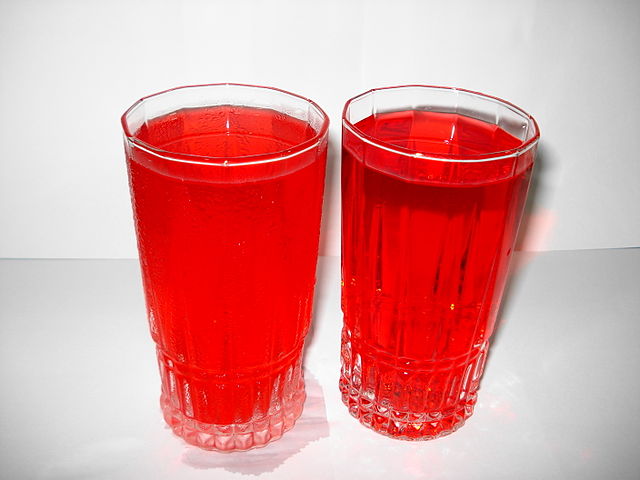Top Qs
Timeline
Chat
Perspective
Rooh Afza
Fruit drink in the Indian sub-continent From Wikipedia, the free encyclopedia
Remove ads
Rooh Afza (Urdu: روح افزا; Hindi: रूह अफ़ज़ा; Bengali: রূহ আফজা; lit. 'Soul Refresher') is a drink which is a concentrated squash.[1] It was formulated and introduced in 1906 in Delhi by Hakim Hafiz Abdul Majeed.[2][3][4][5] Currently, Rooh Afza is manufactured by the companies founded by him and his sons, including Hamdard India (the parent company), as well as Hamdard Laboratories (Waqf) Pakistan and Hamdard Laboratories (Waqf) Bangladesh. Since 1948, the company has been manufacturing the product in India, Pakistan and Bangladesh.[3]
Other companies formulate the same un-patented recipe in these countries as well. The specific Unani recipe of Rooh Afza combines several ingredients popularly believed to be cooling agents, such as rose, which is used as a remedy for loo (the hot summer winds of Northern India and Pakistan and Bangladesh). The drink is commonly associated with the month of Ramadan, in which it is usually consumed during iftar. It is sold commercially as a syrup to flavour sherbets, cold milk drinks, ices, and cold desserts such as the popular falooda.[6] The name Rooh Afza is sometimes translated as "refresher of the soul".[7] It is said that this name was made up by the original formulator of the drink, with possible cultural influences.[8][3]
Remove ads
History
Summarize
Perspective


Rooh Afza was founded by Hamdard's founder Hakim Hafiz Abdul Majeed in Old Delhi, British India. In 1906, he wanted to create a herbal mix that would help Delhi's people stay cool in the summer. He selected herbs and syrups from traditional Unani medicine and created a drink that would help counter heat strokes and prevent dehydration in people. An artist, Mirza Noor Ahmad, designed the labels of Rooh Afza in many colours in 1910. Progress in development and refining the original recipe continued all along until the final drink emerged.[3]
After Majeed's death 15 years later, his wife Rabea Begum established a charitable trust in the name of herself and her two sons.[9]
Following the partition of India in 1947, while the elder son, Hakim Abdul Hameed, stayed in independent India – the younger son, Hakim Mohammad Saeed, migrated to the newly created state of Pakistan on 9 January 1948 and started a separate Hamdard Company from two rooms in the Arambagh area of Karachi.[3][7] Hamdard Pakistan finally became profitable in 1953. Hakim Mohammad Said had opened a branch of Hamdard in the former East Pakistan. According to Hakim Mohammad Said's daughter, Sadia Rashid, chairperson of Hamdard Pakistan in 2019, her father gifted the business to the people of Bangladesh after their independence from Pakistan in 1971.[3]
In 2010, chef Nita Mehta and Indian film actress Juhi Chawla were hired for promotional activities by Hamdard Laboratories to create new mocktail and dessert recipes for Rooh Afza, their all-season summer drink, which was used in a new marketing campaign.[10]
Remove ads
Ingredients
Its original formulation included:[11]
- Herbs:
- Deepak ("khurfa seeds", Portulaca oleracea)
- Chicory
- Wine-grape raisins (Vitis vinifera)
- European white lily (Nymphaea alba)
- Blue star water lily (Nymphaea nouchali)
- Lotus (nelumbo)
- Borage
- coriander
- Rosemary
- Fruits:
- Orange
- Citron
- Pineapple
- Apple
- Berries
- Strawberry
- Raspberry
- Loganberry
- Blackberry
- Cherry
- Concord grapes
- Blackcurrant
- Watermelon
- Vegetables:
- Spinach
- Carrot
- Mint
- Sponge gourd (Luffa aegyptiaca)
- Flowers:
- Rose
- Kewra (Pandanus fascicularis)
- Lemon
- Orange
- Roots:
- Vetiver (Chrysopogon zizanioides)
Remove ads
Preparation
Rooh Afza syrup is generally served mixed with cold milk or water and ice. Rooh Afza is often prepared as part of Iftar (the evening meal for breaking the fast or roza), during Ramadan.[12] The concentrate can also be mixed with water, which is a common preparation in the hot South Asian summers. When mixed with water, the final drink is a type of sharbat. Rooh Afza syrup is often mixed with Kulfi ice cream and vermicelli to make a similar version of the popular Iranian dessert Faloodeh.
Controversies
Summarize
Perspective
Lawsuit & fines in Bangladesh
On the complaint of false information, misleading advertisements and publication of false information on the web site, Safe Food Inspector Kamrul Hassan filed a case against Hamdard Laboratories Bangladesh on May 30, 2018. In the case, he mentions that the information published in the advertisement with 'Rooh Afza made with 35 fruit juice' is not correct.[13] On June 12 of the same year, Pure food court judge AFM Maruf Chowdhury fined the company four lakhs taka for publishing misleading advertisements. If unable to pay the fine, then the Hamdard chairman and managing director would be punished for three months' imprisonment.[14]
Allegations of 'Sharbat Jihad'
In 2025, Baba Ramdev's Patanjali Foods Limited circulated advertisements alleging Rooh Afza to promote "sharbat jihad" i.e undermining Hindu culture & fostering Muslim takeover of the land by construction of mosques & madrasas by the beverage's Muslim owners (as acts of charity) financed by the sales of the beverage raised from Hindus.[15][16] Hamdard India filed a defamation case in the Delhi High Court against Patanjali, which ordered that the advertisements be immediately pulled down.[17]
Remove ads
Variants
Hamdard Laboratories India has launched two ready to drink variants in India namely RoohAfza Fusion and RoohAfza Milkshake.[18][19][20][21]
In Pakistan, one of the ready-to-drink variants, called the Rooh Afza Go,[22] is available in a can form. In addition a drink commonly prepared by parents for kids in Pakistan, is now available as a product from Hamdard Laboratories (Waqf) Pakistan, called the Doodh (milk) Rooh Afza.[23] It is essentially Rooh Afza flavored milk, packaged in a 225ml milk carton.
Remove ads
References
External links
Wikiwand - on
Seamless Wikipedia browsing. On steroids.
Remove ads

